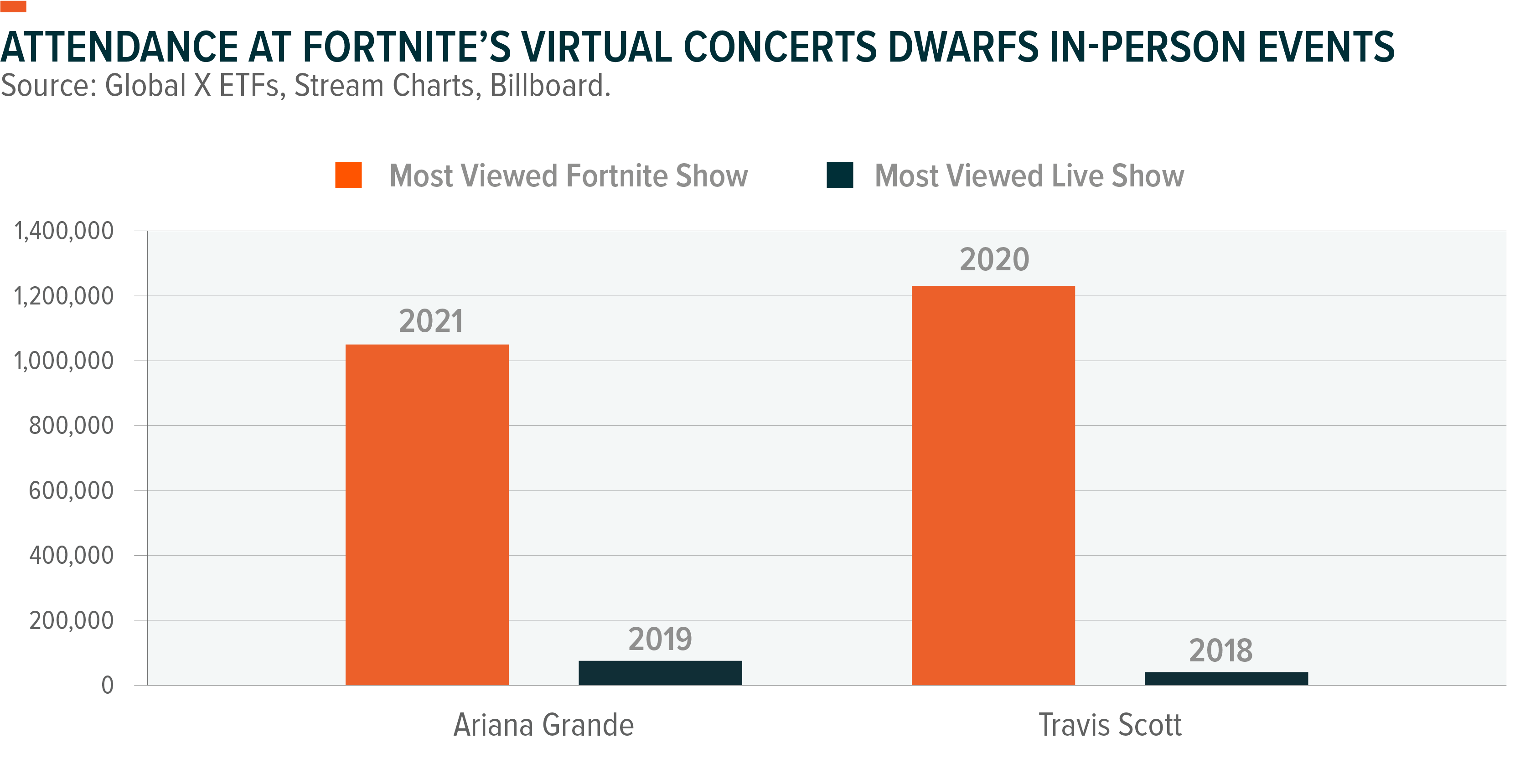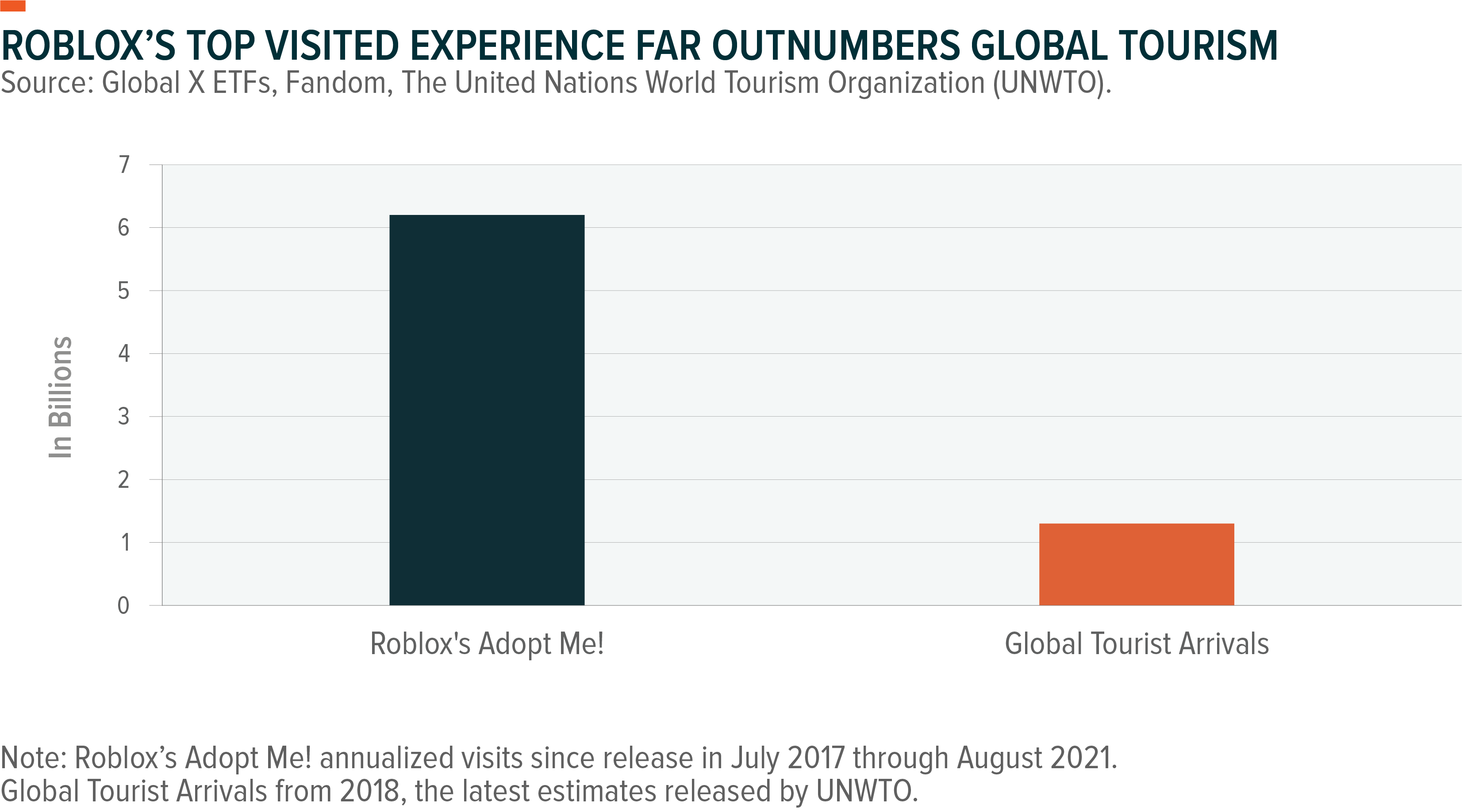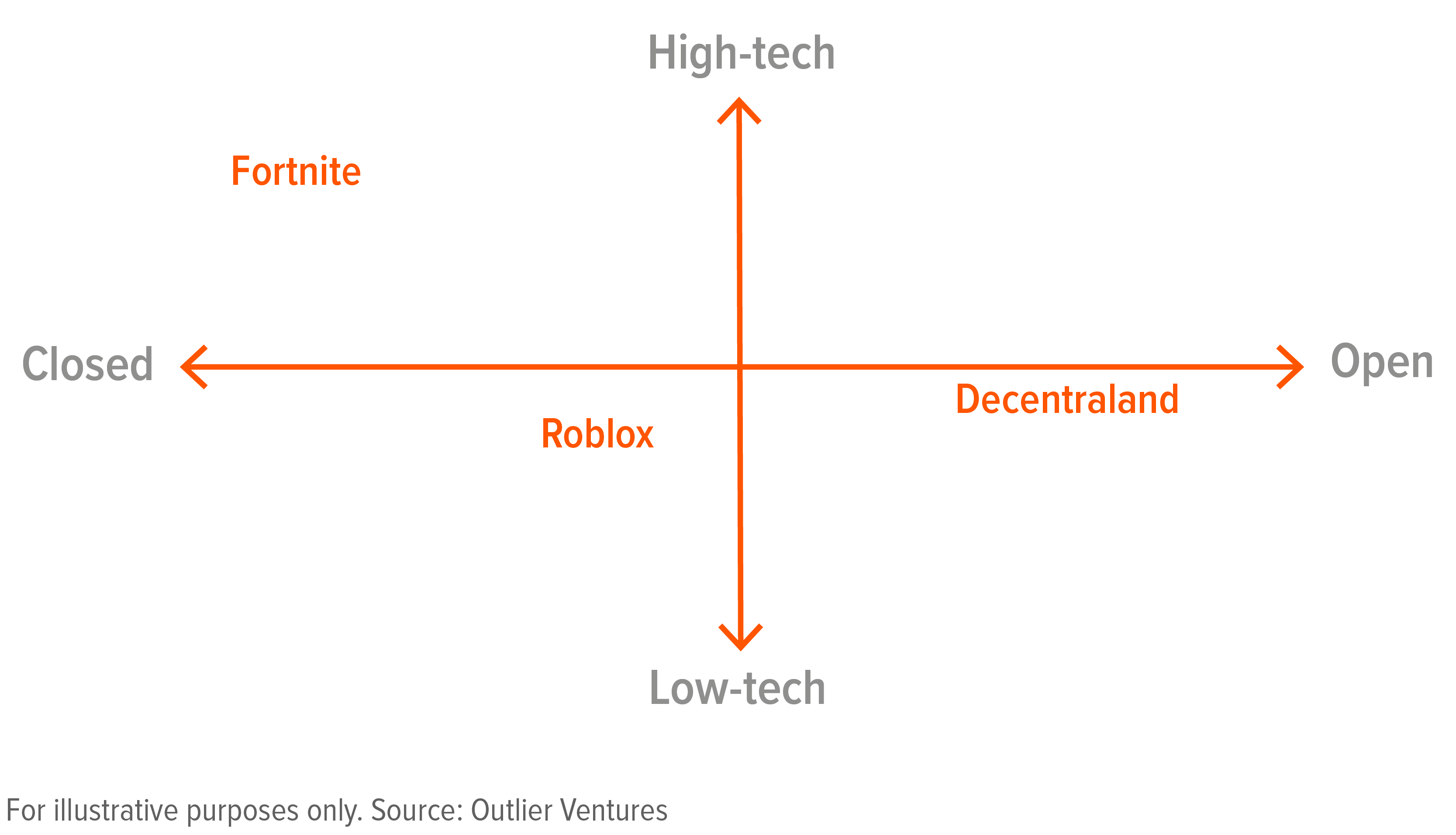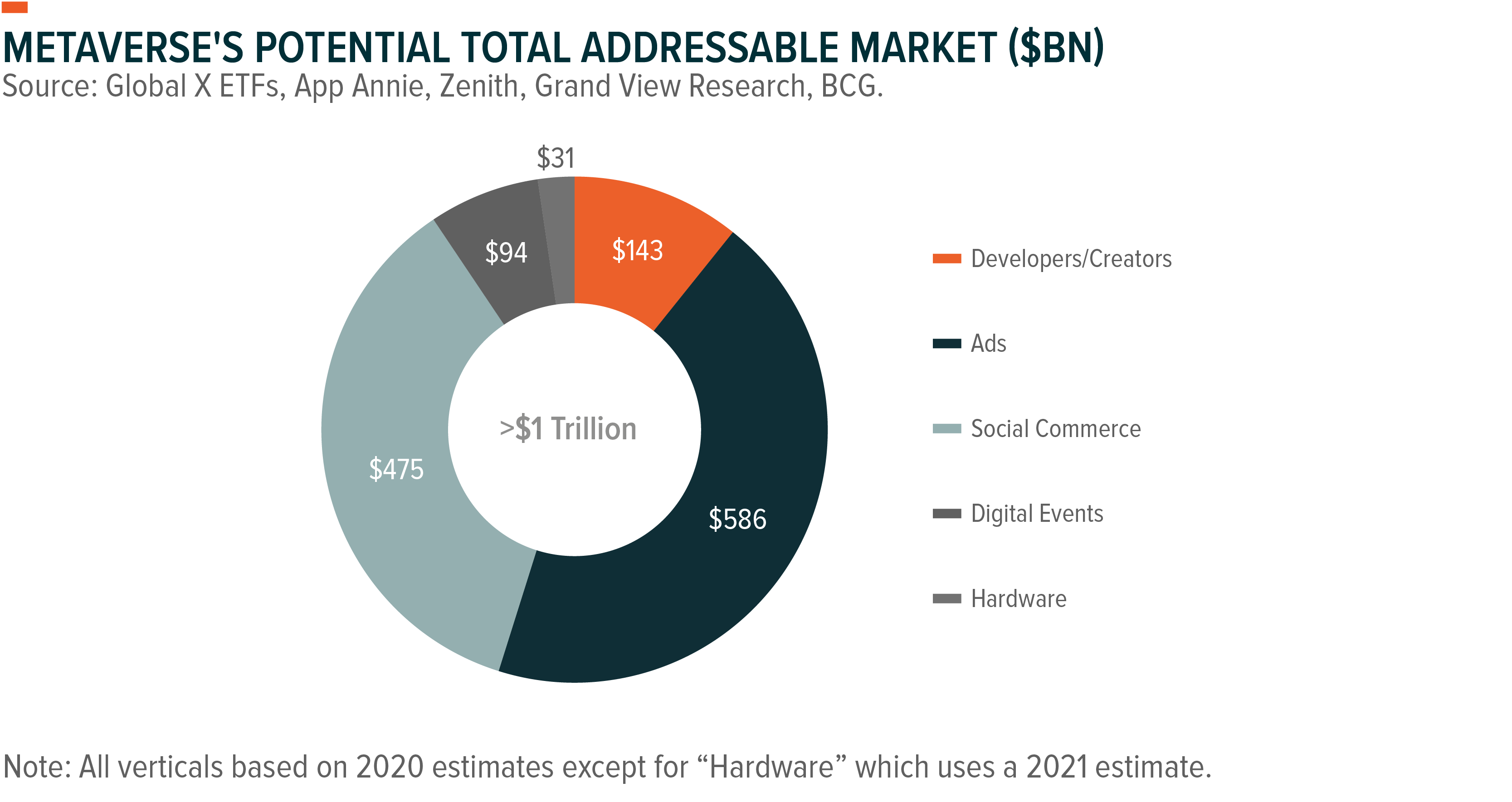On Facebook’s Q2 2021 earnings call, CEO Mark Zuckerberg and others mentioned the metaverse 20 different times. Roblox mentioned the metaverse 16 times on its call and Unity Technologies did so 8 times. Why are leading social media and video game companies so enamored with this term? It’s because many expect the metaverse to emerge as the next evolution of the internet, presenting trillions of dollars of opportunities, as well as risks, to today’s leading platforms and internet giants.
But what is the metaverse and why is it the likely successor to today’s internet? And which themes and segments are best positioned to benefit from this evolution? We’ll discuss these questions in this piece as we explore the metaverse and envision how it could drastically reshape the future.
Key Takeaways
- The metaverse is the next evolution of the internet, one that users are immersed and virtually present in. The metaverse consists of several key features including real-time persistency, economies, communities, digital avatars, and accessibility across multiple devices.
- Early versions of the metaverse exist today, offering investors a glimpse its enormous potential. But a successful metaverse in the future is expected to feature a decentralized, open architecture platform accessed by virtual reality headsets and powered by blockchain technology.
- The concept, if successful, is expected to yield trillions of dollars of opportunities for companies stemming from several themes, including Social Media, Video Games, E-commerce, and Blockchain.
Defining the Metaverse
In today’s internet, we often access different digital platforms because they help facilitate physical-world experiences. We buy goods on Amazon that are shipped to our home, we share pictures on Instagram of our latest dinner out, or we buy tickets online to a concert at Madison Square Garden that we attend with friends.
In the metaverse, digital platforms will contribute largely to digital-world experiences. By jumping into an immersive experience using a virtual reality headset, one can work, play video games, buy digital items, socialize with friends, and consume media, all while present within the metaverse itself. Succinctly, Facebook’s Zuckerberg describes the metaverse as a virtual environment where you can be present with other people in digital spaces.
Broadly, we identify six main characteristics that define a metaverse:
- Identity: While digitally present in the metaverse, users can express themselves as whoever or whatever they want to be with their own avatar. To quote the science-fiction film Ready Player One, which depicts an infinite metaverse called the Oasis: “People come to the Oasis for all the things they can do, but they stay for all the things they can be: tall, beautiful, scary, a different sex, a different species, live action, cartoon, it’s all your call.”
- Multi-device: The ability to access the metaverse from anywhere is a key feature, whether it’s your phone, PC, tablet, or other devices. One of the biggest leaps forward will likely be the immersive virtual reality (VR) experience, which uses a head-mounted display to engulf users in a computer-generated environment where they can manipulate virtual objects. But lighter versions of the metaverse can exist too, via traditional screens and devices.
- Immersive: A truly immersive experience engages all of a person’s senses: sight, hearing, touch, smell, and taste. Today, VR mostly involves surround sound and images. The next generation of VR devices could include haptic body suits and omnidirectional treadmills that give users physical sensations through electro-stimulation as they navigate a digital environment.
- Economy: A fully developed metaverse has a functioning economy where users can earn and spend in digital or fiat currencies. An early example of a metaverse with an online economy is the gaming platform Roblox and its currency, the Robux. Users who purchase Robux can spend it on experiences and items for their avatar. Developers and creators can earn Robux by building engaging experiences and compelling items that users want to purchase, and converting those Robux back into fiat currencies like the US Dollar.
- Community: Users are not alone in the metaverse, but surrounded by others in real time, sharing experiences, and or interacting with one another. Using video games as an early predecessor of the metaverse, we have seen that enabling social experiences seems to be a core trait of successful titles. Activision Blizzard CEO Rob Kotick mentioned that players who play in groups with friends spend over three times more hours in the game and invest roughly three times more on in-game content compared to other players.1
- Real-time Persistent: The metaverse is expected to be real-time persistent with no ability to pause it. It continues to exist and function even after users have left. This trait shifts away the centricity of the user to the virtual world itself.
Early Days of the Metaverse Show Its Potential
The metaverse is not some futuristic idea; early versions already exist. Epic Games’ Fortnite has hosted virtual concerts with Ariana Grande and Travis Scott, where users attended as their digital avatars to enjoy the shared experience with others. The success of these events has been staggering, drawing millions of fans that far outnumbered in-person shows.

Similarly, Roblox’s popular experience Adopt Me! counts 6.2 billion annual visits on average since its release in July 2017.2 And Adopt Me! is just one of the thousands of places available to visit in Roblox’s platform. To the extent that traveling in virtual worlds and the real world are quasi-comparable, the metaverse could become an economical form of on-demand mass transit to explore new places, people, and cultures. For comparison, pre-pandemic, international tourist arrivals around the globe totaled 1.4 billion annually.3 The city with the most annual international visits pre-pandemic was Bangkok with approximately 23 million.4

In August 2021, Facebook took a major step towards a metaverse offering when it unveiled “Horizon Workrooms,” a virtual meeting space where co-workers can interact with each other in the form of their digital avatars. Entering the workroom requires an Oculus VR headset and downloading the free app.
Each of these examples offer bits and pieces of what a full metaverse could ultimately look like. As companies invest further in building metaverse-related initiatives, it’s important to remember that what we call ‘the metaverse’ isn’t necessarily a centralized monopoly. Metaverse development may yield more centralized and distinct experiences currently, but it’s working towards an end-state that is a fully decentralized. And unlike in Ready Player One, which depicts a metaverse where the real world is left behind for one infinite virtual world, in our world several metaverses are likely to emerge.
The Metaverse of the Future Expected to Move from Closed to Open Architecture
Today, companies offer their metaverse experiences primarily through closed architecture systems, which means that their software and/or hardware is not compatible with other platforms. And different platforms are often designed for different primary use cases, such as gaming, working, shopping, or socializing. Eventually, however, we expect the most successful metaverse platforms to evolve toward a more open architecture that allows all (or at least many) parties—users, developers, and companies—to participate on equal terms.
For users to participate, they will simply need an entry point, whether it’s a VR set, smartphone, or PC, and an internet connection. When inside the most popular metaverse platform, we expect users to find functioning economies where they can spend or earn currency. Many will view the metaverse as a space for entertainment and leisure – using the digital space to meet with friends, shop, or consume media. These platforms will benefit from network effects, with more users resulting in richer digital experiences, thus attracting more users like family, friends, and acquaintances.
But equally important to a successful and thriving metaverse will be fostering a community that values the contributions of developers and creators who build the goods and experiences for the majority of users to enjoy. For these developers, the metaverse will be their place of work, whether they are designing a new game, digital items, or entire virtual worlds.
A truly open metaverse can be a decentralized virtual reality platform powered by blockchain technology. Such a concept already exists today with Decentraland, which is built on the Ethereum blockchain, giving community members the chance to create, experience, and monetize content and applications. Unlike other virtual worlds and social networks, no single agent has the power to modify the rules of Decentraland’s software, land, or the economics of its currency.5 Community members can buy, develop, and sell land, which, like in the real world, is finite, making it more valuable.

The Metaverse Is a Trillion-Dollar Opportunity
We expect the metaverse to create wide-ranging revenue opportunities across multiple verticals, particularly for those companies that develop virtual platforms and their components, semiconductors and chips that render ultrarealistic graphics, and the related software.

- Developer/Creator Economies: Just like Apple built an ecosystem where developers sell their apps, a thriving metaverse requires a robust third-party developer base that sells experiences and accessories. If the $200 billion earned by Apple’s App Store developers from 2008–2020 is any indication, the economy for developers in the metaverse could be massive.6 Developers for Roblox earned $328.7 million in 2020 and $248.7 million just in the first half of 2021.7, 8 Similar potential exists on the creator side: Alphabet’s YouTube has paid creators a total of $30 billion over the last three years.9 Critically, developer revenues are often shared with the social media or video game platforms themselves. Just as Apple famously receives 30% of app store revenues, metaverse platforms are likely to extract similar economics.
- Ads: Social media platforms are known for offering free services to users, with revenues largely driven by targeted advertising. Increasingly, gaming companies are following similar paths, offering users free-to-play experiences that are subsidized by ads and in-game purchases. Metaverse experiences are likely to follow a similar path, featuring in-platform ads that promote real-life physical items as well as ads for digital metaverse-oriented items, including games, accessories, experiences, and other products. According to one estimate, the metaverse could be a $500 billion-plus market disruptor for the global media advertisement industry.10
- Social Commerce: E-commerce platforms could evolve from selling goods on websites to offering their products within virtual malls, where users buy digital items for their virtual life and real-world items that they can have delivered to their door. In a virtual mall, one could look at items with friends, talk to an influencer about the product, and digitally try out the good before purchasing. In many ways, it’s the next iteration of social commerce, or the intersection between e-commerce and social media, which generated $475 billion globally in 2020 according to one estimate.11
- Digital Events: Beyond just being a video game, Fortnite emerged during the COVID-19 pandemic as a social hub for users who wanted to virtually attend concerts, see movie trailer premieres, and watch movies. Digital events are likely to be a major offering within the metaverse going forward. For example, you could virtually attend concerts, movies, sports, or e-sports events with your friends, while enjoying the conveniences of being physically in your own home. Going back to Ariana Grande’s Fortnite concert, the singer earned an estimated $20 million for her virtual appearance.12 The global virtual event market is estimated to be $94 billion, of which revenues are likely to be split between the content creators (e.g. the movie studios, professional sports teams, and artists) and the metaverse platforms that host these events.13
- Hardware: Virtual reality and augmented reality headsets, graphic chips, and omnidirectional treadmills are just some of the high-tech hardware that are likely to play major roles in building an interactive and immersive metaverse. By 2024, the hardware market could grow from an estimated $31 billion in 2021 to $297 billion.14 Looking at just VR technology applicable to the metaverse, the opportunity could be greater than $100 billion.15
- Wallets & Applications: As financial transactions move to the metaverse, new services will emerge. Users will need to easily convert between fiat and digital currencies, transact in digital currencies to purchase goods, and custody their digital purchases somewhere. FinTechs, especially those focused on the blockchain space, could play critical roles in facilitating these transactions and ensuring rightful ownership. In exchange, these companies are likely to charge for transactions, foreign/virtual exchange conversions, and/or custodial services.
The Metaverse: Where Several Disruptive Themes Converge
The metaverse is still in its early days, but the infrastructure is being built piece by piece and social attitudes are changing such that we may soon be ready to experience a new era of the internet. While it may take several years for fully formed, immersive metaverse experiences to become ubiquitous, earlier stage investment opportunities are emerging across multiple themes, including Social Media, Video Games, E-commerce, and Blockchain. At the heart of the opportunity are the social media and video game companies leveraging their large user bases, creator platforms, experiences with live digital events, and cutting-edge hardware to build the foundations of the metaverse. Beyond that, powerful e-commerce firms are likely to benefit from new sales channels and features, while blockchain companies are likely to be essential in providing the financial infrastructure underpinning the metaverse economy. While in the real world each of these themes continue to disrupt and redefine the status quo, we believe the metaverse presents billions of dollars of new opportunities for each of these themes.
Related ETFs
HERO: The Global X Video Game & Esports ETF seeks to invest in companies that develop or publish video games, facilitate the streaming and distribution of video gaming or esports content, own and operate within competitive esports leagues, or produce hardware used in video games and esports, including augmented and virtual reality. Click the fund name above to view current holdings.
SOCL: The Global X Social Media ETF seeks to provide investment results that correspond generally to the price and yield performance, before fees and expenses, of the Solactive Social Media Total Return Index.
EBIZ: The Global X E-commerce ETF seeks to track the Solactive E-commerce Index, which focuses on companies positioned to benefit from the increased adoption of e-commerce as a distribution model. This includes companies whose principal business is in operating e-commerce platforms, providing e-commerce software and services, and/or selling goods and services online.
BKCH: The Global X Blockchain ETF seeks to provide investment results that correspond generally to the price and yield performance, before fees and expenses, of the Solactive Blockchain Index. BKCH seeks to invest in companies positioned to benefit from the increased adoption of blockchain technology, including companies in Digital Asset Mining, Blockchain & Digital Asset Transactions, Blockchain Applications, Blockchain & Digital Asset Hardware, and Blockchain & Digital Asset Integration.
Click the fund name for holdings information. Holdings are subject to change. Current and future holdings are subject to risk.
 Pedro Palandrani
Pedro Palandrani